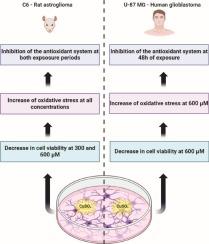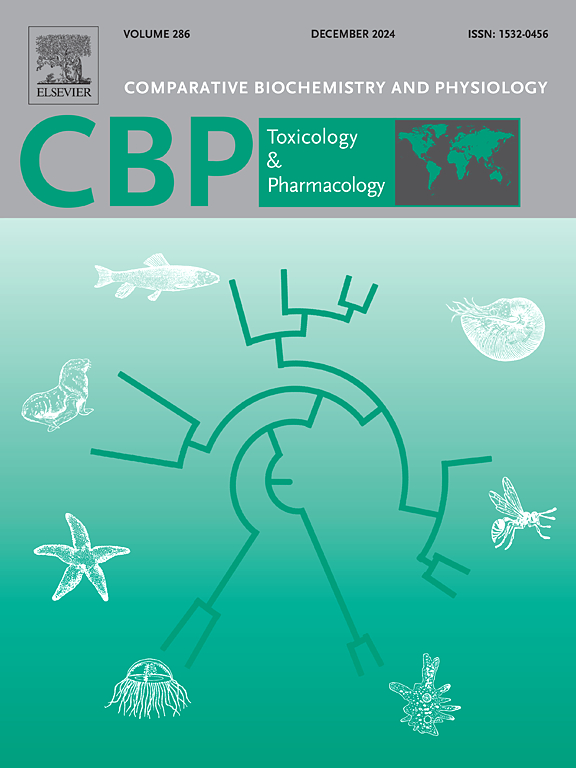Assessing antioxidant responses in C6 and U-87 MG cell lines exposed to high copper levels
IF 3.9
3区 环境科学与生态学
Q2 BIOCHEMISTRY & MOLECULAR BIOLOGY
Comparative Biochemistry and Physiology C-toxicology & Pharmacology
Pub Date : 2024-11-04
DOI:10.1016/j.cbpc.2024.110065
引用次数: 0
Abstract
Copper excess has been tested as an anticancer therapy, due to its properties to generate oxidative stress resulting in tumoral cell death. Thus, this study aimed to evaluate the impact of copper excess on oxidative stress and antioxidant responses in glioma cells, establishing the antioxidant system as a target of copper toxicity in tumoral cells. C6 and U-87 MG cells were exposed to CuSO4 (0–600 μM) for 24-48 h. SOD, CAT, GPx, GR, and CK activities, protein and non-protein thiol levels (PSH and NPSH), and O2− production were assessed, alongside SOD1, GPx1, and GR gene expression. Results revealed a decrease in GPx, GR, and CAT activity after CuSO4 exposure in both cell lines over 24-48 h, while SOD activity initially increased, then declined after 48 h. CK activity was also decreased in C6 cells. NPSH and PSH levels dropped after 24 h, and O2− production was observed in all CuSO4 concentrations. GR mRNA was reduced in both cell lines, contrasting with increased GPx1 mRNA in C6. U-87 MG cells exhibited higher levels of SOD1 mRNA, while C6 cells displayed lower expression. Our findings suggest that copper excess limits antioxidant enzyme activity and thiol levels, particularly in the C6 cells, likely attributable to oxidative stress or direct copper-enzyme interactions. Moreover, our results imply differences in copper toxicity regarding the cell lineage used, highlighting the importance of analyzing high copper levels effects in different models. Moreover, it could be proposed that the antioxidant system is a target of copper toxicity, contributing to glioma cell death.

评估暴露于高浓度铜的 C6 和 U-87 MG 细胞系的抗氧化反应。
铜过量会产生氧化应激,导致肿瘤细胞死亡,因此已被测试为一种抗癌疗法。因此,本研究旨在评估铜过量对胶质瘤细胞氧化应激和抗氧化反应的影响,将抗氧化系统确定为肿瘤细胞铜毒性的靶点。将 C6 和 U-87 MG 细胞暴露于 CuSO4(0-600 μM)24-48 小时。在评估 SOD1、GPx1 和 GR 基因表达的同时,还评估了 SOD、CAT、GPx、GR 和 CK 活性、蛋白质和非蛋白质硫醇水平(PSH 和 NPSH)以及 O2-产生情况。结果显示,在接触 CuSO4 24-48 小时后,两种细胞系的 GPx、GR 和 CAT 活性都有所下降,而 SOD 活性最初有所上升,48 小时后又有所下降。C6 细胞中的 CK 活性也有所下降。24 小时后,NPSH 和 PSH 水平下降,在所有 CuSO4 浓度下都观察到 O2-产生。两种细胞系的 GR mRNA 都减少了,而 C6 细胞的 GPx1 mRNA 则增加了。U-87 MG 细胞的 SOD1 mRNA 水平较高,而 C6 细胞的表达较低。我们的研究结果表明,铜过量限制了抗氧化酶活性和硫醇水平,尤其是在C6细胞中,这可能归因于氧化应激或铜与酶的直接相互作用。此外,我们的研究结果表明,铜的毒性因所使用的细胞系而异,这凸显了在不同模型中分析高浓度铜效应的重要性。此外,可以认为抗氧化系统是铜毒性的一个靶点,导致了胶质瘤细胞的死亡。
本文章由计算机程序翻译,如有差异,请以英文原文为准。
求助全文
约1分钟内获得全文
求助全文
来源期刊
CiteScore
7.50
自引率
5.10%
发文量
206
审稿时长
30 days
期刊介绍:
Part C: Toxicology and Pharmacology. This journal is concerned with chemical and drug action at different levels of organization, biotransformation of xenobiotics, mechanisms of toxicity, including reactive oxygen species and carcinogenesis, endocrine disruptors, natural products chemistry, and signal transduction with a molecular approach to these fields.

 求助内容:
求助内容: 应助结果提醒方式:
应助结果提醒方式:


